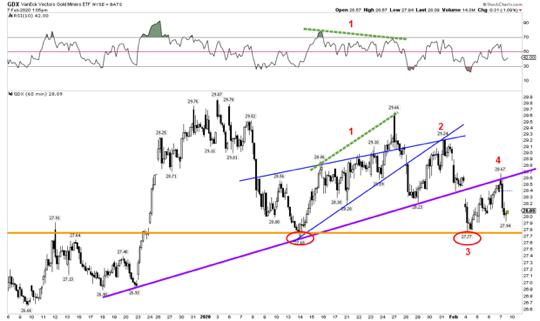I have written my last several pieces about the gold futures COT report and, since nothing has really changed on that front, I thought it might be worthwhile to look at GDX, the ETF basket of gold miners.
Below is the 60-minute GDX chart spanning 2 months, labeled with points 1 through 4, which I address:

Source: StockCharts.com, 2/7/20
Looking at the annotated chart above and using the red numbers for reference, this is my take on GDX:
1. The dashed green line highlights the weeklong RSI(10) negative divergence with price. GDX climbed higher before spiking to 29.66, all the while RSI trended lower, indicating that momentum was stalling.
2. GDX price formed a bearish wedge (blue lines), then broke out bullishly to 29.66 (classic first-way-wrong-way move), only to then fail and fall back into the wedge. GDX then broke lower out of the wedge and cleanly retested the broken uptrend line of the wedge from below, before then rolling over.
3. GDX next gapped below the larger (purple) uptrend line from December, bottoming at the horizontal support (orange line) just below 28.
4. Bouncing higher from support, GDX cleanly retested the broken uptrend line (purple) and has now reversed back to the 28 area (as I write).
So where does that leave us? The bull case is that the double bottom and horizontal support at 27.70 (point #3, orange line) holds and GDX works its way higher next week. On the bearish side is the breaking of the uptrend line (purple), which has been cleanly retested from below (point #4). Of course, a lot depends on what gold does next week. There is obviously a great deal of headline risk based on what news comes across the wire on the coronavirus and its effect on health and global trade. I will be watching closely, focusing on what I see on the price chart and trying to avoid seeing what I "think" should happen.
Questions and comments are always welcome: ttaschler@sprottglobal.com.
Tim Taschler, CMT
Sprott USA
Past performance does not guarantee future results. The views and opinions expressed herein are those of the author's as of the date of this commentary and are subject to change without notice. This information is for information purposes only and is not intended to be an offer or solicitation for the sale of any financial product or service nor a recommendation or determination by Sprott Global Resource Investments Ltd. that any investment strategy is suitable for a specific investor. Investors should seek financial advice regarding the suitability of any investment strategy based on the objectives of the investor, financial situation, investment horizon and their particular needs. This information is not intended to provide financial, tax, legal, accounting or other professional advice, since such advice always requires consideration of individual circumstances. The products discussed herein are not insured by the FDIC or any other governmental agency, are subject to risks, including a possible loss of the principal amount invested.
Generally, natural resources investments are more volatile on a daily basis and have higher headline risk than other sectors, as they tend to be more sensitive to economic data, political and regulatory events as well as underlying commodity prices. Natural resource investments are influenced by the price of underlying commodities like oil, gas, metals, coal, etc., several of which trade on various exchanges and have price fluctuations based on short-term dynamics partly driven by demand/supply and also by investment flows. Natural resource investments tend to react more sensitively to global events and economic data than other sectors, whether it is a natural disaster like an earthquake, political upheaval in the Middle East or release of employment data in the U.S.. Low-priced securities can be very risky and may result in the loss of part or all of your investment. Because of significant volatility, large dealer spreads and very limited market liquidity, typically you will not be able to sell a low priced security immediately back to the dealer at the same price it sold the stock to you. In some cases, the stock may fall quickly in value. Investing in foreign markets may entail greater risks than those normally associated with domestic markets, such as political, currency, economic and market risks. You should carefully consider whether trading in low-priced and international securities is suitable for you in light of your circumstances and financial resources. Past performance is no guarantee of future returns. Sprott Global, entities that it controls, family, friends, employees, associates and others may hold positions in the securities it recommends to clients and may sell the same at any time. The author received no compensation for writing this article.
